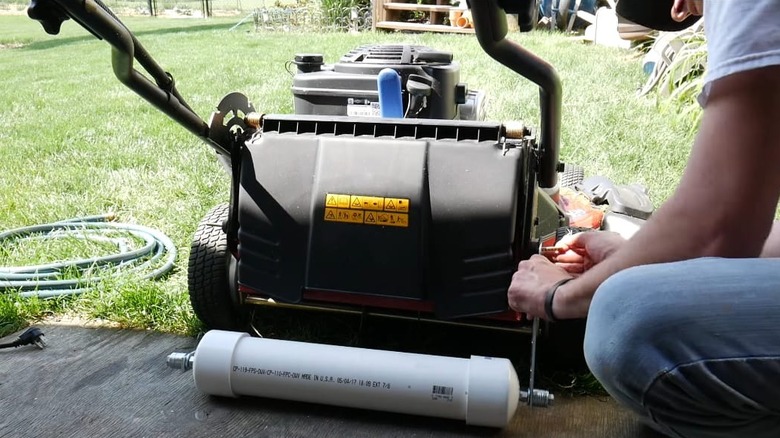Here's How To Get A Plaid Lawn Worthy Of An English Garden
We may receive a commission on purchases made from links.
Imagine stepping into your backyard that exudes the timeless sophistication of an English garden, your grass meticulously arranged in an eye-catching plaid pattern. It's a vision that immediately conjures up images of the regal lawns of Windsor Castle and the tactically striped tennis courts of Wimbledon. And did we mention that these aesthetics stemmed from competition among British homeowners, each vying to outshine the other with grandeur displays of garden landscaping? Now you know.
"How do I get stripes on my lawn?" you might ask. Contrary to common misconceptions, the key to a plaid English garden-esque mow pattern is not chopping your grass at different heights but is an intricate dance of bending the grass blades. Picture the mesmerizing effect when brushing velvet fabric in varying directions, revealing alternating shades of light and dark. Striping your lawn comes with a similar enchantment. Lawn grass, much like velvet, takes on different hues depending on whether it's bent toward or away from the light.
With a bit of patience, a mower, and a lawn striping kit, even the most bland lawn can be transformed into an English garden-like spectacle.
How do you mow a lawn with a plaid pattern?
Mastering the art of lawn mowing with the elegant plaid pattern is like learning to dance the Paso Doble: movements must be precise and patterns synchronized. It all begins with the right equipment. You need a reliable lawn mower, no doubt, but your key to this coveted plaid mow pattern is a lawn striping kit. The Toro Striping System found on Amazon and the EZTrak Grass Groomer Striping Kit LP1000 at Walmart are worthy companions on this quest. A lawn striping kit, however sophisticated, will obediently adhere to your commands if you follow its installation manual meticulously.
Some kits require adding sand to the roller for that extra heft that helps bend the grass blades, delivering an amplified, dramatic visual contrast. The inaugural stripe should be mowed in a careful straight line parallel to a defined path in your yard. Upon reaching the edge of your lawn, pivot the mower to start a fresh line beside the just-created stripe in the reverse direction. This choreography yields alternating light and dark lines. To make the crisscross pattern in your lawn, simply repeat the same mowing procedure, only this time forming stripes perpendicular to the original ones. Once done, step back and take pride in the captivating tableau before you — an elegant canvas of crisscrossing stripes that scream passion and skill.
Precautions and alternatives for lawn striping
Certain precautions are non-negotiable when mowing your lawn in a plaid pattern that rivals an English garden. First, cut only when the grass is dry. Wet grass can clog your mower, form unsightly clumps, and turn the mower into a slipping hazard on sloped lawns. And as diseases often thrive in moisture, the wet grass is their breeding ground, and your mower becomes an unwitting accomplice in their spread.
Consistency and precision are critical, so adjust your mowing height accurately to prevent undue stress and damage to your grass. Plus, you need enough height to catch the sun to highlight the stripes in all their glory. A carefully considered mowing schedule will suffice. That could be weekly or bi-weekly in summer, based on your lawn's growth rate and type. Make sure to overlap your rows slightly — just a couple of inches — for a consistent plaid pattern. As a final touch, leave no clippings lingering on your lawn.
Regarding the alternatives, one idea is creating a homemade lawn striping kit by packing sand or gravel into a dense 3-inch PVC pipe that can slot right between your mower's wheels. And if a typical checkerboard pattern doesn't tickle your fancy? Consider other exciting pattern alternatives. That includes a diagonal design, double striping (a pair of identical lines in one direction, followed by another pair in the opposite direction), and circle patterns. The possibilities are as stretchy as your creativity.


